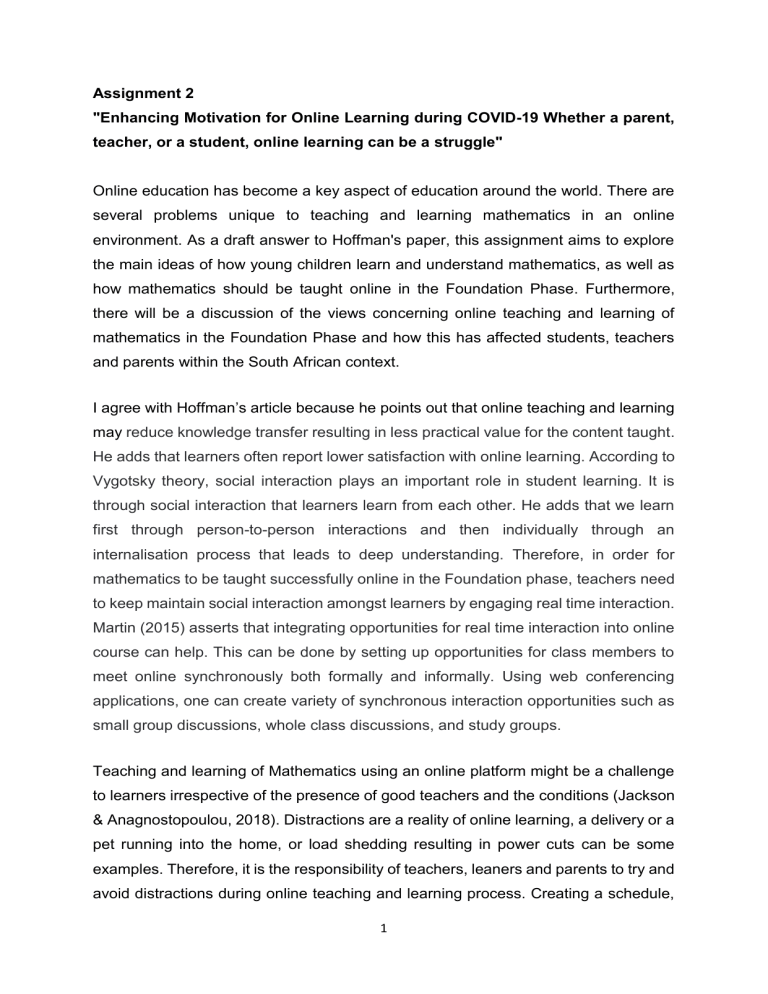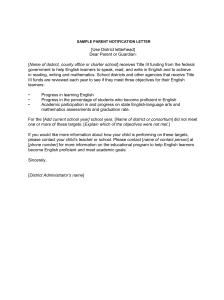
Assignment 2 "Enhancing Motivation for Online Learning during COVID-19 Whether a parent, teacher, or a student, online learning can be a struggle" Online education has become a key aspect of education around the world. There are several problems unique to teaching and learning mathematics in an online environment. As a draft answer to Hoffman's paper, this assignment aims to explore the main ideas of how young children learn and understand mathematics, as well as how mathematics should be taught online in the Foundation Phase. Furthermore, there will be a discussion of the views concerning online teaching and learning of mathematics in the Foundation Phase and how this has affected students, teachers and parents within the South African context. I agree with Hoffman’s article because he points out that online teaching and learning may reduce knowledge transfer resulting in less practical value for the content taught. He adds that learners often report lower satisfaction with online learning. According to Vygotsky theory, social interaction plays an important role in student learning. It is through social interaction that learners learn from each other. He adds that we learn first through person-to-person interactions and then individually through an internalisation process that leads to deep understanding. Therefore, in order for mathematics to be taught successfully online in the Foundation phase, teachers need to keep maintain social interaction amongst learners by engaging real time interaction. Martin (2015) asserts that integrating opportunities for real time interaction into online course can help. This can be done by setting up opportunities for class members to meet online synchronously both formally and informally. Using web conferencing applications, one can create variety of synchronous interaction opportunities such as small group discussions, whole class discussions, and study groups. Teaching and learning of Mathematics using an online platform might be a challenge to learners irrespective of the presence of good teachers and the conditions (Jackson & Anagnostopoulou, 2018). Distractions are a reality of online learning, a delivery or a pet running into the home, or load shedding resulting in power cuts can be some examples. Therefore, it is the responsibility of teachers, leaners and parents to try and avoid distractions during online teaching and learning process. Creating a schedule, 1 identifying a quiet place, if one gets distracted by social media or browsing the internet, use of tools to block out these distractions can help learners during online learning. Hoffman asserts that, regardless of instructional synchronization, the teacher's presence is critical for motivating online learners. Active instructor participation demonstrates to students that the teacher is enthusiastic about delivering online instruction. He talks about active participation based on a theory called constructivism. Active learning is a process that has the learner at its centre. It focuses on how learners learn, not just on what they learn. Baviskar and Hartle (2019) say that learners are encouraged to think hard rather than passively receive information from the teacher. With active learning, students play an important part in their own learning process. They build knowledge and understanding in response to opportunities provided by their teacher. This means that learners are more able to analyse, evaluate and synthesise ideas (thus achieving the higher order of Bloom’s taxonomy). Therefore, in order for mathematics to be successfully taught in Foundation Phase, teachers has to apply active participation in online lessons. Teachers should include activities such as pre-tests, informal interviews and small group warm-up activities that require recall of prior knowledge. Teachers and parents should allow learners in pairs to teach each other. However, it is also the duty of teachers and parents to make sure that learning is in progress and that there learners are passing each other the correct information. If teachers, students, and parents are all highly motivated to meet the set goals, online teaching and learning of mathematics can be aided remotely. According to Skinner (1983), highly motivated students are frequently actively and spontaneously interested in activities and find the learning process delightful without expecting any external rewards. Teachers need to be enthusiastic, praise learners often, and recognise them for their contributions. Another way to encourage learners is to get them involved in the classroom. Rewards also can be used to motivate learners. Teachers must teach through games and discussions instead of lectures, encourage them to debate and enrich the subject matter with visual aids like colourful charts, diagrams and videos. Another way to motivate learners during mathematics lessons is to draw connections to real life. Making use of familiar shops, names, cars, streets, TV, shows makes them to be actively involved during online lessons. 2 I agree with Hoffman’s point that, regardless of instructional synchronization, the teacher's presence is necessary to encourage online learners. He goes on to say that strong instructor involvement demonstrates to students that the teacher is enthusiastic in delivering online instruction. It's critical to make regular contributions, provide comments, and show sympathy for the predicament of students (Shea et al., 2006). South African schools are now clustered into quintiles ranging from one to five. This was done to ensure an equal and fair distribution of resources across schools. This approach was introduced to address past inequities which affected schools. To keep supporting learners, the teachers are using online teaching resources and conducting one on one consultations using platforms like Zoom, WhatsApp and Google messaging services that allow video calls. The WhatsApp messaging service has been repurposed for learning. Schools have created WhatsApp learning groups to take pictures of book pages and sent them to parents, while learners receiving teaching material through their smartphone apps have enabled classes to continue. The Department of Education has also launched a complementary WhatsApp portal to provide teachers with information about COVID-19 and educational material (Dube, 2020). Learner-centered education employs interactive ways to engage students and help them develop their skills. This educational approach assists students in developing abilities such as decision making and problem solving, teamwork, and presenting skills that are important to today's labour market (Villela, 2016). This can be done through fostering collaboration with group projects. Teachers have to let learners develop content. For example, by uploading podcasts or videos for learners and let them work individually or in groups to contribute to it. Staging of presentations also help here. Learners will have to provide live feed or record themselves then share to other learners and to the teacher. Not only does this help learners learn the topic, but also get a chance to develop another workplace skill, presenting. Some activities include role play, brainstorming, holding debates and competitions, gamifying learning with features such as leader boards, badges, points, that will encourage learner participation (Villela, 2016). 3 Conclusively, the essay has explored the main ideas of how young children learn and understand mathematics, as well as how mathematics should be taught online in the Foundation Phase. Furthermore, there was a discussion of the views concerning online teaching and learning of mathematics in the Foundation Phase and how this has affected students, teachers and parents within the South African context. It was observed that it is highly possible for mathematics to be successfully taught to young learners in the Foundation Phase. One may agree that it is therefore the duty of the teacher, learners and parents to make online teaching and learning of mathematics to be a success. Tools such as Zoom, WhatsApp, has proved to be accommodating majority of learners in both developed and underdeveloped schools. Hoffman’s article has also proved that online teaching and learning can be a success if carefully implemented by teachers, learners and parents. 4 REFERENCES Hoffman, B. 2020. Enhancing Motivation for Online Learning during COVID-19. Whether a parent, teacher, or a student, online learning can be a struggle. [Online]. Available at: https://www.psychologytoday.com/us/blog/motivate/202005/enhancingmotivationonline-learning-during-covid-19. (Accessed on 15 SEPTEMBER 2021) Kim, K and Frick, T, W. (2011). Changes in Student Motivation During Online Learning. Macmillan. New York Martin, A. (2020). How to Optimise Online Learning in the Age of Coronavirus (Covid19) A Guide for Educators. UNSW Publishers. Australia Piaget, J. (1971). The theory of stages in cognitive development. McGraw-Hill Savery, J, R. (2015). Educational Technology. Problem based learning: An instructional model and its constructivist framework. University of Akron. South China Villela, M. (2016). The Power of Student Driven Learning. Barker College. Ottawa, Canada Vygotsky, L. S. (1978). Mind in society: the development of higher psychological processes. Harvard University. London 5

